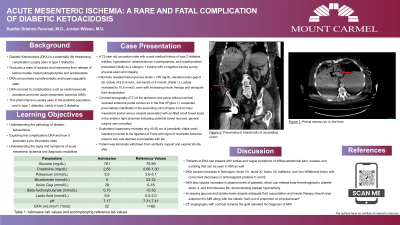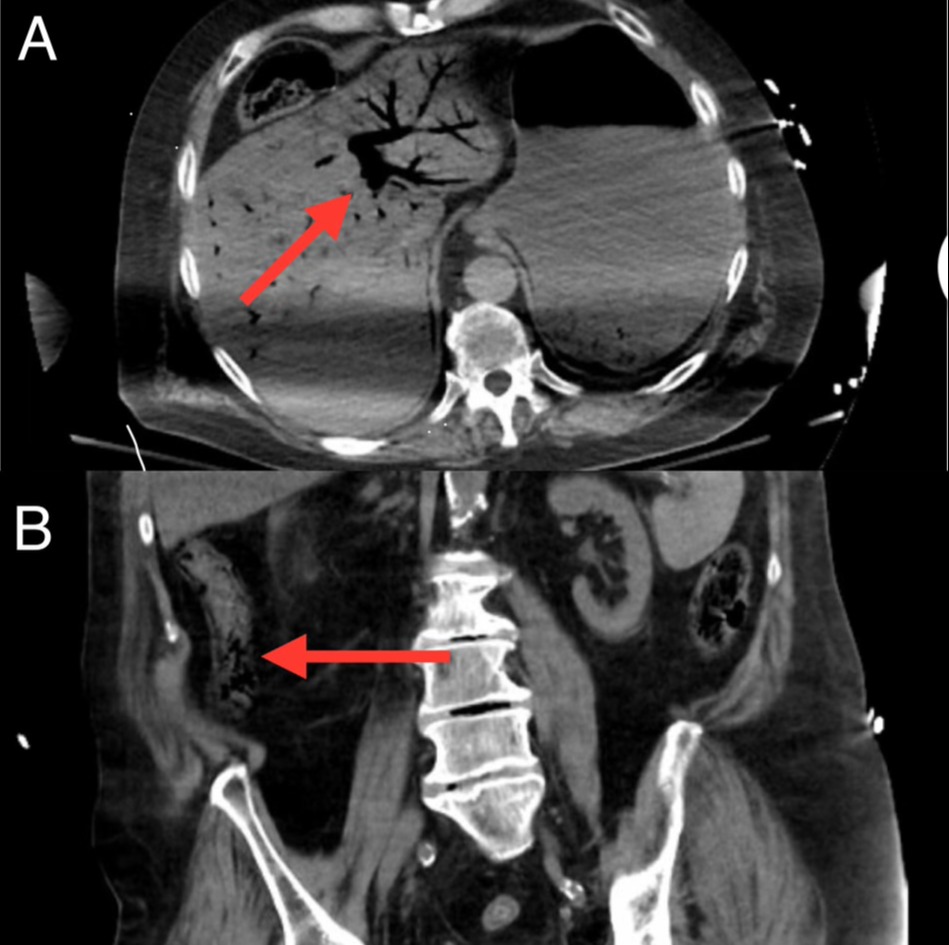Tuesday Poster Session
Category: Small Intestine
P4991 - Acute Mesenteric Ischemia: A Rare and Fatal Complication of Adult Diabetic Ketoacidosis
Tuesday, October 29, 2024
10:30 AM - 4:00 PM ET
Location: Exhibit Hall E

Has Audio

Karthic Drishna Perumal, MD
Mount Carmel Health System, OH
Presenting Author(s)
Karthic Drishna Perumal, MD1, Jordan Wilson, MD2
1Mount Carmel Health System, Powell, OH; 2Mount Carmel Health System, Grove City, OH
Introduction: Diabetic ketoacidosis (DKA) is a potentially life-threatening complication usually seen in individuals with type-1 diabetes mellitus, rarely in type-2 diabetes, that manifests a state of ketonemia and metabolic acidosis. An often overlooked complication of DKA is its ability to promote a prothrombotic state, which can lead to cerebrovascular accidents and even acute mesenteric ischemia.
Case Description/Methods: We present a 72-year old male with a history of T2DM, hypertension, atherosclerosis, came to the ED as a category 1 trauma, found down on his bathroom floor for 12-15 hours with unclear loss of consciousness. The patient arrived tachycardic, normotensive, saturating 100% on 4 L nasal cannula with a GCS of 11. Remaining aspects of the primary and secondary survey, and FAST examination performed in the trauma bay were all unremarkable. Imaging obtained at that time including chest, pelvic, right lower extremity plain films from hip to ankle, and computed tomography (CT) of the head and vertebral column showed no acute traumatic findings or signs of acute abdomen. Labs on admission showed glucose levels of 700 mg/dL, lactate of 9.8, anion gap of 28, bicarbonate of 9, and pH of 7.17 and insulin therapy was initiated. Despite analgesics, aggressive fluid resuscitation, and increasing insulin therapy, he continued to have worsening lactate of 10.6mmol/L, glucose levels of 772 mg/dL, and abdominal pain, which prompted a computed tomography (CT) of the abdomen and pelvis. CT revealed extensive portal venous air and suspected pneumatosis intestinalis indicating potential bowel necrosis leading to a surgery consult for emergent exploratory laparotomy; only 45-50 cm of potentially viable mesentery proximal to the ligament of Treitz was present and thus was not compatible with life.
Discussion: Diabetes is a proven hypercoagulable state with increases in prothrombotic factors and an overall increase in platelet release products. AMI classically presents as “pain out of proportion”, but nausea, vomiting, and abdominal pain are common symptoms seen in DKA as well. However, if even after adequate fluid resuscitation and insulin therapy there is worsening acidosis and abdominal pain, it is important to maintain a high degree of clinical suspicion for AMI. CT angiography is still considered first-line, highly sensitive diagnostic evaluation and should be obtained regardless of renal function, as early identification and intervention is critical to improving patient morbidity and mortality.

Note: The table for this abstract can be viewed in the ePoster Gallery section of the ACG 2024 ePoster Site or in The American Journal of Gastroenterology's abstract supplement issue, both of which will be available starting October 27, 2024.
Disclosures:
Karthic Drishna Perumal, MD1, Jordan Wilson, MD2. P4991 - Acute Mesenteric Ischemia: A Rare and Fatal Complication of Adult Diabetic Ketoacidosis, ACG 2024 Annual Scientific Meeting Abstracts. Philadelphia, PA: American College of Gastroenterology.
1Mount Carmel Health System, Powell, OH; 2Mount Carmel Health System, Grove City, OH
Introduction: Diabetic ketoacidosis (DKA) is a potentially life-threatening complication usually seen in individuals with type-1 diabetes mellitus, rarely in type-2 diabetes, that manifests a state of ketonemia and metabolic acidosis. An often overlooked complication of DKA is its ability to promote a prothrombotic state, which can lead to cerebrovascular accidents and even acute mesenteric ischemia.
Case Description/Methods: We present a 72-year old male with a history of T2DM, hypertension, atherosclerosis, came to the ED as a category 1 trauma, found down on his bathroom floor for 12-15 hours with unclear loss of consciousness. The patient arrived tachycardic, normotensive, saturating 100% on 4 L nasal cannula with a GCS of 11. Remaining aspects of the primary and secondary survey, and FAST examination performed in the trauma bay were all unremarkable. Imaging obtained at that time including chest, pelvic, right lower extremity plain films from hip to ankle, and computed tomography (CT) of the head and vertebral column showed no acute traumatic findings or signs of acute abdomen. Labs on admission showed glucose levels of 700 mg/dL, lactate of 9.8, anion gap of 28, bicarbonate of 9, and pH of 7.17 and insulin therapy was initiated. Despite analgesics, aggressive fluid resuscitation, and increasing insulin therapy, he continued to have worsening lactate of 10.6mmol/L, glucose levels of 772 mg/dL, and abdominal pain, which prompted a computed tomography (CT) of the abdomen and pelvis. CT revealed extensive portal venous air and suspected pneumatosis intestinalis indicating potential bowel necrosis leading to a surgery consult for emergent exploratory laparotomy; only 45-50 cm of potentially viable mesentery proximal to the ligament of Treitz was present and thus was not compatible with life.
Discussion: Diabetes is a proven hypercoagulable state with increases in prothrombotic factors and an overall increase in platelet release products. AMI classically presents as “pain out of proportion”, but nausea, vomiting, and abdominal pain are common symptoms seen in DKA as well. However, if even after adequate fluid resuscitation and insulin therapy there is worsening acidosis and abdominal pain, it is important to maintain a high degree of clinical suspicion for AMI. CT angiography is still considered first-line, highly sensitive diagnostic evaluation and should be obtained regardless of renal function, as early identification and intervention is critical to improving patient morbidity and mortality.

Figure: A) Portal venous gas indicating intestinal ischemia
B) Pneumatosis intestinalis found in the ascending colon
B) Pneumatosis intestinalis found in the ascending colon
Note: The table for this abstract can be viewed in the ePoster Gallery section of the ACG 2024 ePoster Site or in The American Journal of Gastroenterology's abstract supplement issue, both of which will be available starting October 27, 2024.
Disclosures:
Karthic Drishna Perumal indicated no relevant financial relationships.
Jordan Wilson indicated no relevant financial relationships.
Karthic Drishna Perumal, MD1, Jordan Wilson, MD2. P4991 - Acute Mesenteric Ischemia: A Rare and Fatal Complication of Adult Diabetic Ketoacidosis, ACG 2024 Annual Scientific Meeting Abstracts. Philadelphia, PA: American College of Gastroenterology.
